Media | Articles
Wrapping Up the Armada
It was early February that I bought the 2008 Nissan Armada with 183,000 miles on it, along with a bunch of known problems—and several unknown ones. If my intent was to buy something that would generate a solid six weeks of content for these columns, it was successful beyond measure. But although I may be strategic, I’m not actively masochistic. Now that I’m through with the big slug of wrenching and I’ve largely gotten the Armada on its feet, I thought I’d step out of the garage and write something a bit more philosophical.
In a world full of inexpensive needy cars, I do have standards. I either buy things that my right brain craves or that my left brain convinces me that I need. This one was squarely in the latter camp. My rationale for buying the Armada was that last September I sold my giant, low-mileage 2008 Chevy Silverado 3500 Duramax duallie because: a) it was way more truck than I ever needed, b) in the 2 ½ years I owned it, I hadn’t used it to drag a single car home anyway, and c) I’d rather have the money than the truck. That all made sense, and I didn’t regret selling it one iota, but as soon as it was gone, I felt that my style had been cramped. So I decided to look at other vehicles capable of towing a car and dragging home other stuff (I did need a workbench). Given the choice between a pickup and a large SUV, I settled on the latter.
I’ve owned six Suburbans, and for a number of reasons, didn’t want a seventh. I was attracted by Toyota Sequoias’ excellent repair record, but the first-generation ones had frame-rot issues, and the second-gen ones were way more than I wanted to spend. I certainly never craved an Armada, but I came to them as the other full-sized Japanese tow-capable SUV, sort of the Pepsi-Burger-King to Toyota’s Coke-McDonalds, and I was thrilled to find that there were a fair number of them in my $4000-ish budget.
I don’t know about you, but when I buy a car, there’s an internal calculus that occurs regarding the asking price, what I paid, and what it took me, time-and-money-wise, to sort the thing out and get it road-worthy. The proportions of these variables depends on whether it’s an enthusiast car or more of a commodity-like daily driver. With enthusiast cars, the older I get, the less I feel like haggling. It’s not that I don’t have the energy. It’s more that, for example, everyone knows that a dead but rust-free, round-taillight BMW 2002 has a lot of value, so do I want to be the person who knows and respects that fact, or do I want to be another time-wasting lowballing jerk? But with daily drivers, most 15-year-old high-mileage needy cars—particularly those with rust (which is ALL OF THEM here in the Northeast)—don’t have a lot of value, and thus it’s reasonable to expect flexibility from the seller to come up with a reasonable price if they really want to move the thing out of their driveway.
Let me zoom in a bit more on that point. In a high winter-salt environment like New England, at some point, most cars that are daily-driven through the winter simply turn into pieces of junk. Some makes and models are better about it, some are worse, but the tin worm catches up with most. Even if there’s no visible rust on the outer body, and the frame and floor pans are solid, every other bit of undercarriage metal—springs, shocks, trailing arms, brake line fittings, and everything down to the hose clamps—rusts, presenting a continuum from minor surface rust, to deeper scale, to full-on rot. Having to replace a single component, like a trailing arm, due to rust-through isn’t that big of a deal, but when there’s an upper and a lower trailing arm on each side, front and back, deciding to go all-in on a project like that on a car that isn’t worth much becomes prohibitive.
Marketplace
Buy and sell classics with confidence
So in looking for a vehicle like I was at a $4000 price point, there’s a threshold for rust beyond which, even if the rust itself isn’t catastrophic, the effect it has on the value of the car is. That is, if a vehicle not only has a rust hole in the outer body but also has, say, rotted trailing arms, unless there’s some other big compelling feature about it like a rare color or option package, it probably isn’t worth buying even if the seller drops the price to $800. When you’re looking for a vehicle and are confronted with these things, the choices are to keep looking and hope you get lucky, or raise your budget to find something with fewer rusty miles—or settle.
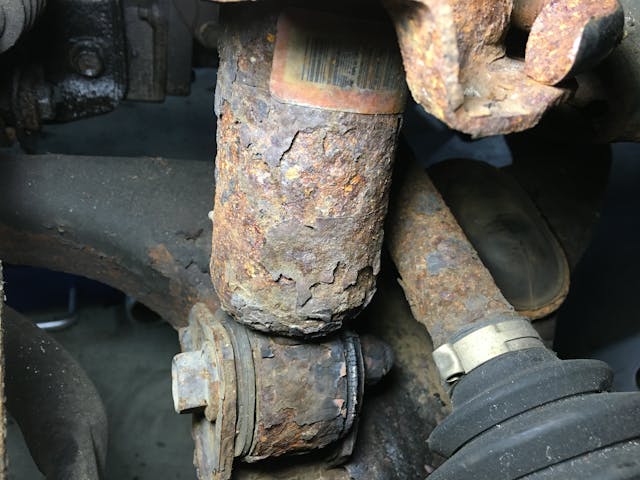
The Armada was initially listed on Facebook Marketplace for $4500. I liked the look of its black-on-black-leather and the fact that it was an LE with the tow package and wood accent trim. When the seller dropped the listed price to $4000, I went and had a look. The truck was off the road (his family had bought a new Tahoe), so I could only drive it slowly on back roads. This less-than-thorough test drive added a measure of risk, but it ran and drove well, other than banging in the front end likely due to bad struts and less-than-reassuring brakes likely due to rusty rotors, though they did begin to bite more as I stomped on them. I also found an exhaust leak, though I couldn’t tell from where, and plugging in the code reader revealed catalytic converter-based codes from both banks, but when cleared they didn’t immediately re-light. It did have one rust hole in the outer body (you can’t see it unless you open the right rear door), but the truck was only about 40 minutes from my house, and it was big and comfortable and had a small turning radius. I had the feeling that I could end my search by simply buying it and then, rather than continuing to look, I’d have the tow-and-stuff-hauling vehicle I said I wanted, as well as something my wife would drive if the weather turned sour. In other words, it was never about wanting the truck—it was wanting what the truck was for. So I asked the seller my favorite “What do you need to get for it” question. He said $3500, I went home and thought about it, offered him three, and we quickly settled on $3250.
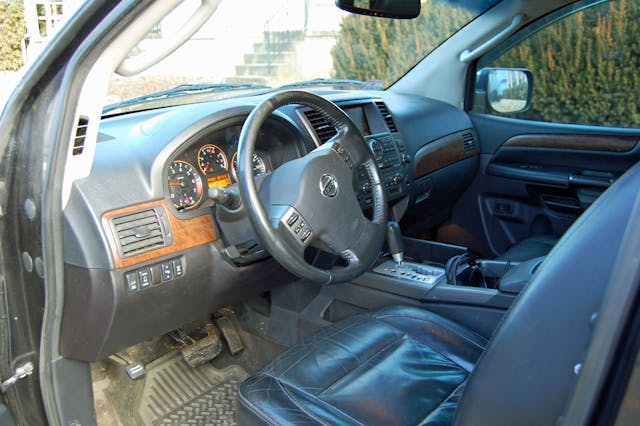
With that in mind, you can see why, after I bought the truck, I felt like I had $750 to play with to get it to the point where I felt comfortable driving it a few hours to tow a car home, or loaning it to my wife if a lot of snow was predicted.
So, how’d I do?
I got out of the leaky exhaust for $46 worth of parts needed to splice a woefully-botched weld joining the muffler to the tailpipe (and I really don’t understand why some of y’all gave me grief for using steel adapters, big U-clamps, and muffler cement to seal it up and pass the second-most-stringent vehicle inspection in the country).

A whining/rumbling serpentine belt tensioner pulley resulted in my replacing the whole tensioner system (belt, tensioner with pulley, and idler pulley) for $115. Rumbling from the power steering pump made me think that it was bad too. I bought a low-mileage used OEM one for $81, but the noise went away after I replaced the tensioner and stanched a power steering fluid leak.

The original radiator’s upper and lower plastic tanks were both leaking. A new aluminum radiator was sourced for $172, which, by the time I added new upper and lower radiator hoses, coolant, and clamps, rose to $248.
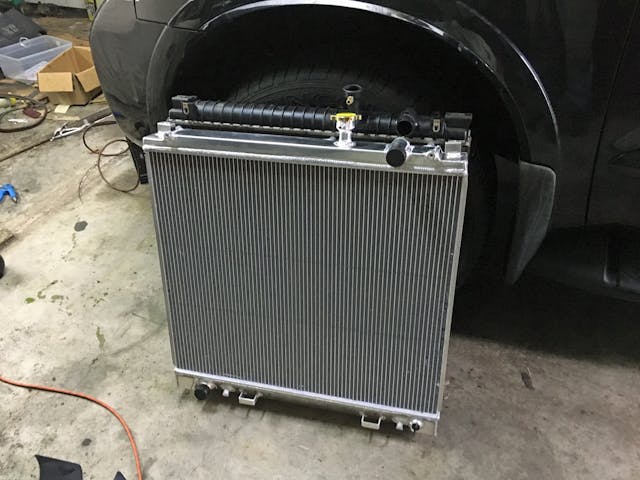
I didn’t try to cheap out on the front struts at all, using Bilsteins and replacing every rubber bushing and spacer, setting me back $305. Finding out that both front springs were broken added another $115, for a total of $420.
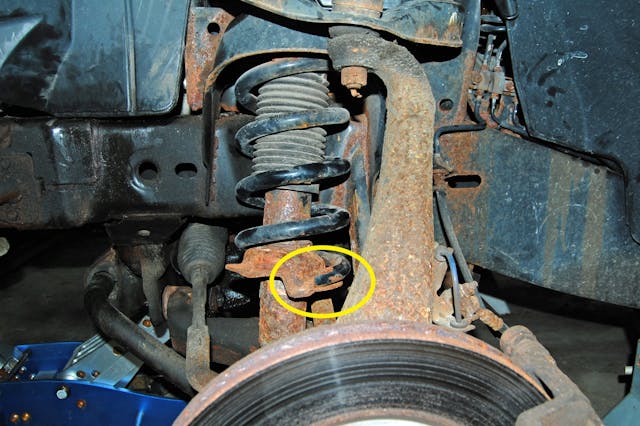
Added up, the parts bill came to $910—slightly higher than my meaningless mental budget of $750. I could’ve easily kept it in line had I dialed back my choices with the front struts, or replaced only the noisy tensioner pulley instead of the whole tensioner system, but I’m comfortable with those choices, as I am with the repairing the exhaust as opposed to replacing it.
I’ve long said that I don’t know how anyone affords to own a vintage car if they have to pay someone else to do the work, but the same holds true for high-mileage daily drivers. Although doing all of the above tasks took time, none were really that big of a deal (it wasn’t, for example, drivetrain replacement), plaus my labor is free and I enjoy doing it. But it certainly made sense for the previous owner to sell it when he did—if you had to pay someone to do everything I did, it would’ve substantially exceeded the value of the truck.
There still are, of course, some unresolved issues. I haven’t yet looked at the car’s self-leveling rear suspension to see if I can get the back level with the front. There’s an asymptomatic P0011 engine code (“camshaft position timing over-advanced, or system performance bank 1”) that comes back every 40 or so miles. You can generally look up codes on a user forum and get a crowdsourced diagnosis (e.g., “that one’s usually the MAF sensor”), but this appears to be an odd one. I’m not certain whether the car’s A/C is working or not—I haven’t yet hooked up a manifold gauge set or fed 12V directly to the compressor—and there’s a clicking sound that I assume is the blend door inside the climate control box trying to move. And—dare I say it with my history with the mouse-infested truck—I’ve noticed that the car has a faint rodent smell.
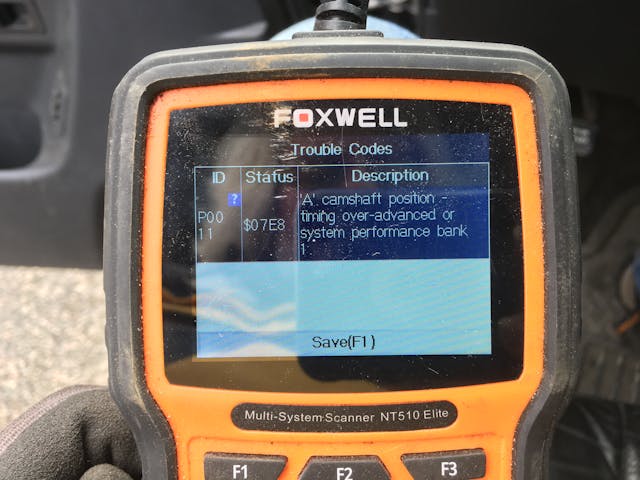
Regarding having a 4WD beast that I could give to my wife if she was going on one of her quilting retreats up in New Hampshire, it’s been such a mild winter that that was a complete non-issue.
But, you’re thinking, with it road and tow-worthy, I must’ve hauled home some right-brain-satisfying passion car that’s really worth my wrenching time, right?
Yeah, about that.
I’m sure the Armada’s towing hour will come, but it hasn’t come yet. So far, the only thing I’ve hauled with it has been a free office desk I’m now using as that long-desired workbench in my basement. I suppose you could say that the free workbench cost me $4160. And, in truth, I grabbed it right after I bought the Armada, before I’d done a single repair on it.
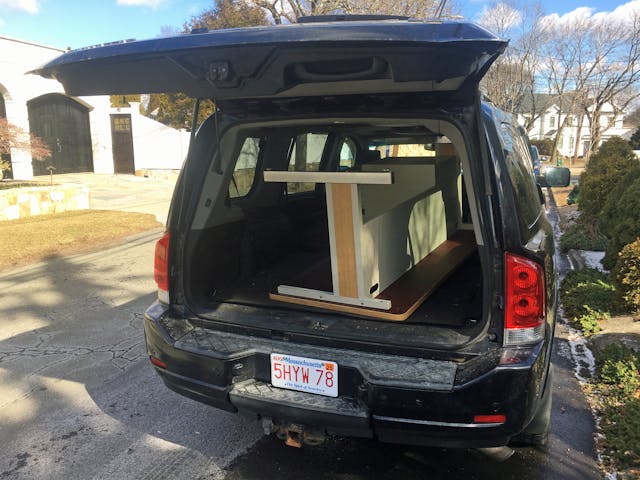

But I do feel better having the Armada in the driveway, knowing that if I need to drop everything and take a look some right-priced TVR or Avanti or Fiat 124 Sport Coupe, and need to show up with a truck, trailer, and money and make it go away, I can make a beeline to U-Haul, grab an auto transporter, and hit the road.
Or begin thinking of a place to put another work bench.
***
Rob’s latest book, The Best Of The Hack Mechanic™: 35 years of hacks, kluges, and assorted automotive mayhem is available on Amazon here. His other seven books are available here on Amazon, or you can order personally-inscribed copies from Rob’s website, www.robsiegel.com.
Check out the Hagerty Media homepage so you don’t miss a single story, or better yet, bookmark it. To get our best stories delivered right to your inbox, subscribe to our newsletters.
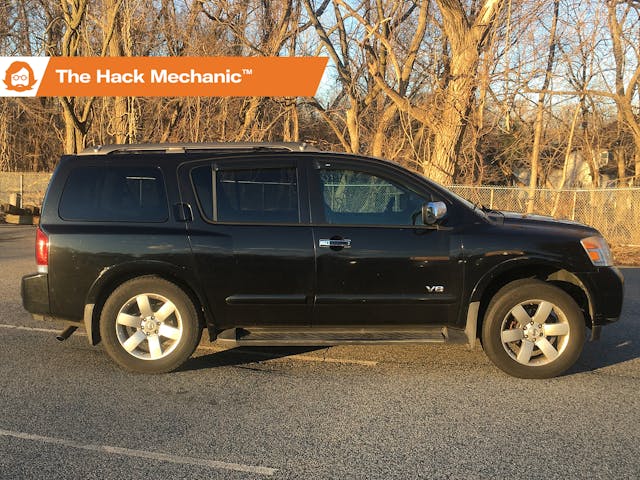












For the record, I didn’t say a WORD about the exhaust fix… 😊
The real question is how it holds up. You have just gotten the t starting line of ownership. If you can get 5 years with little investment you did well. But if you are out towing another car home or to another place and something gives up it may not feel as successful at that time.
I have been around and used many patched together models over the years but most are more simple and easier to adress models to repair. Mostly based domestic trucks with solid frames and engines with bodies that were good enough.
The simpler the less risk. Here you have a more complicated vehicle that may pay off but could still go the other way.
At this point spin the wheel and see if you win or sink with the Armada.
Rob, great summary. Now that you have a road worthy car, we want to invit you and your understanding better half down to Gettysburg on June 14 and or 15 to a great car show. As there will be about 400 cars in attendance including you neighbor Laurie K that has of last month spent around $30K at one of your local shops, Hyannis Vintage Auto, getting her 1970 ready for the drive down. We will be at the Wyndham and the Marriott Courtyard but you may have to room at another budget motel as those two are sold out. See you there…
I’m actually kind of sad to see conclusion to this rig’s saga.
There’s something just so satisfying about bringing a high mileage unit of any kind back in to fighting shape. I like seeing machinery get resurrected just as much as seeing it get used.
The way I see it, you got a hauling rig and kept another set of wheels out of the scrapyard for just a *little* bit longer.
This has absolutely no connection to Rob’s story (but might – he likes old crap) – I have an old Ingersoll Rand single cylinder double-acting compressor, nearly complete – that I would really like to get rid off if someone will just come get it – no charge, will help get it off the foundation and loaded on your rig. Gave up after many attempts to reach our to Jay Leno – who seemed to be the perfect match – but is basically unreachable. Located in Shreveport, Louisiana Reach me at 318/573-1233
I don’t think the outlay of cash was too bad. If it proves to be a reliable transport you’ve done well.
Rob – with your investment in the Armada, have you thought about an oil under coating to slow the rust? I’ve had fantastic results with Fluid Film, and recently used NH Oil Undercoating and Wool Wax with equal performance. I don’t think anything will ever stop iron from rusting, but the oil does wonders to slow it to crawl.
Its not without its detriments though. Its a sloppy mess to work on a vehicle that is properly coated. I mean absolutely disgusting. The lanolin products also stink like a barnyard. 🙂
This is such a small amount of money to have in a vehicle. Yesterday I was looking at new Lincoln Navigators that ranged from $95K-$100K. Having $4K invested is chump change compared to something new. And, I find this quote interesting: “But it certainly made sense for the previous owner to sell it when he did—if you had to pay someone to do everything I did, it would’ve substantially exceeded the value of the truck.” Why is this relevant? I paid $5000 for a 2011 Ford Crown Vic Police Interceptor a few years ago. I have added at least $6000 more into it, but the value of the car is probably still around $5000. That does not bother me. People who buy new vehicles lose a bunch after a year or two. Vehicles that are driven should not be looked at as investments. If you want to talk about investments, I recommend mutual funds.
I’ve found that simply not repairing/replacing/sealing leaky gaskets and seals and just maintaining oil and ATF levels give pretty much the same results! 😁
I completely agree!
DUB6……thanks for confirming that you are your own best audience.
Rob…..thanks for the great story! Suggest you invest in some bars of Irish Spring. (Not for you, for the AC ducts, just in case!).
What did I learn today? That one must be VERY careful of where the comment box is when one clicks “post comment”! Also, I learned that Pete G can come up with some pretty clever stuff when he wants to! 😁👍
Yeah I figured you weren’t intending on agreeing with yourself, but sometimes the fingers are just compelled to type. I bow…….
I try to stay clear of Japanese products the American ones are trouble enough and I’m getting old enough to start having trouble wrenching on the ones that I have but I keep trying c’mon warmer weather!!!
Watching South Main Auto on YouTube has appaled me with how quick NE vehicles turn to junk and are scrapped
This story reminds me of what my long term restoration mechanic told me early in our relationship: “ There are only two types of cars worth owning: #1 Race cars; #2 Cars on warranty.” There is a fair amount of truth and wisdom in this statement.
Rob,
It seems to me that the bulk of your car problems are caused by where you choose to live. Out here in Seattle, you can find pretty much whatever you want without a trace of rust. And there’s no annual inspection.
I was a bit surprised about the Sequoia having rust issues. I drive a 2003 beat up Tundra for a work truck (315K and going strong… knock on wood…) and no rust issues at all. Then you said that dirty word… SALT. Forgot you live “up there”. I’m in South Carolina where we don’t have to worry about that.
$4160 tied up in a daily driver that is as useful as this one isn’t a bad investment. He can keep it and put miles on it and get all or most of that money out a year or two later when he’s lost interest. For me, personally, my level of satisfaction in a vehicle is inversely proportional to the amount of money I have tied up in it. This is a perfect example of a great daily driver beater.